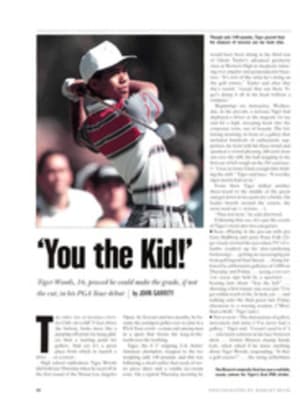
On the Button
The 3-D gym, tucked into the farthest corner of a short, no-name alley hidden behind a shopping center in Colorado Springs, is the sort of place where you would expect to find America's top amateur fighters sharpening their mean skills. This is no trendy fitness center filled with people high-stepping to a rock beat. The only music heard there last week was the grunting of six laboring boxers and the heavy sound of leather whacking against hard bodies.
As these six trained for the World Championships Challenge, to be held on March 13 and 14 in Tampa, the boxers were mindful of the new electronic scoring system for amateur boxing that has drastically changed the sport and consequently their style of fighting. Stay off the ropes. Jab, jab and jab again. Punch to the body and make the judges hear the blows. Box out in the open, where at least three of the five judges can see your punches. "What are you doing on the damn ropes? Get the hell off there!" Pat Nappi, the 73-year-old coach of the U.S. national team, said repeatedly at the 3-D to Eric Griffin, America's 106-pound world champion and the best amateur boxer in the world.
Last Saturday night, a few miles to the west of the 3-D, at the Broadmoor Hotel, another two dozen amateurs faced off in the 12 title bouts of the U.S. Championships in hopes of winning berths at the Olympic trials in Worcester, Mass., in June. These boxers also had to contend with scoring computers, both on Saturday and through four days of preliminary matches at the nearby Olympic Center. "We're stuck with the damn thing," says Nappi, who was the U.S. Olympic coach in 1976 and '84. "But that doesn't mean I have to like it."
Traditionalists like Nappi aside, the lords of amateur boxing rightly concluded after the 1988 Games in Seoul, which set an Olympic record for scandalous decisions, that there was a critical need for a neutral computer to score bouts. Juan Antonio Samaranch, the president of the International Olympic Committee, ordered boxing either to clean up its act or forget about being an Olympic sport. "Boxing embarrassed itself in Korea," says Jerry Dusenberry, the vice-president of USA Amateur Boxing and the U.S.'s resident expert on electronic scoring.
The scoring had been too subjective. Some decisions were not merely bad, they were sheer larceny. Electronic scoring, which was adopted by the International Amateur Boxing Association (AIBA) in 1989, should end that. Each of the five judges, who are seated at different locations around the ring, is given a box with two buttons, one for each boxer. When a judge sees a scoring punch, he pushes the button for the fighter who landed it. At least three of the five judges must score the punch within one second of its being thrown for the blow to be recorded by the computer. The winner of a bout is the boxer who has tallied the most scoring punches. It's that simple.
A fighter now must stay away from the ropes so that his punches will not be obscured by the body of his opponent or by the referee. A stunning shot to the head or body is wasted if only two judges witness it. Anyone can see a jab, but for it to be a scoring blow, the jab must be hard and crisp. "No more shoe shining," says Olympic coach Joe Byrd. "Now you have to hit somebody."
Amateur boxing has always been a game for headhunters. Now body punching, a tactic of the pros, will play a far more important role. In a pre-Olympic tournament in Barcelona from Feb. 15 to Feb. 22, Emil Jetchev of Bulgaria, chairman of the AIBA's judges and referees, ordered his charges to start scoring more body punches. "We have lived with a myth," says Dusenberry. "We were scoring on impressions. Electronic scoring has exposed the weakness of the old system. Now we have accountability. A punch is a punch, and it is one point, period."
Under the old system, the winner of a round was awarded 20 points, and his opponent earned anywhere from 19 points, if the round was close, to 16, if it wasn't. On Saturday night Chris Byrd, who was voted the national tournament's outstanding boxer, won 76-13 over Eric Wright in the 165-pound final. Byrd was superb, but the bout was not as much of a mismatch as the score indicated.
Byrd, the 21-year-old son of the Olympic coach, is probably the best example of electronic scoring's influence on boxing styles. Until recently he was a counter-puncher who loved to work with his back against the ropes. Last year, in a U.S. Cuba dual meet, he defeated Ramon Garbey under the old scoring system, three rounds to none. However, with the new scoring system in place during the world championships in November in Sydney, Australia, Byrd, still fighting off the ropes, lost 20-6 to Garbey. The judges could not score what they could not see.
"Dad ordered me to stay off the ropes," said Byrd before the national championships. "And Pat Nappi told me to stay way the hell out in the center of the ring."
Remaining away from the ropes as he battled past three opponents in the preliminary bouts in Colorado Springs, Byrd, a southpaw from Flint, Mich., stopped Harold Roberts in Round 1 of their fight before defeating Ronald Simms and Ray Berry by the combined score of 65-19. In the final against Wright, Byrd gave an aggressive performance that looked to be right out of a textbook.
Joining Byrd and Saturday night's 23 other finalists at the Olympic trials will be the 12 armed forces champions, another 12 Golden Gloves champions, 24 fighters selected by regional boxing committees, plus boxers who will have received at-large berths based on their international rankings. Among this last group will be the six fighters who were working out at the 3-D, including Griffin and two other possible gold medalists, Oscar dc la Hoya at 132 pounds and Ivan Robinson at 125.
The beauty of the qualifying system for the trials is that by awarding a free pass to proven boxers, the door is left open at the national championships for unknowns to make their mark. Last week for the first time, the spotlight was on Arturo Hoffman, 17, a high school junior from Dade City, Fla., who defeated Russell Roberts 40-19 to win the 112-pound championship. Hoffman, though, is not likely to win at the trials. The favorite is Tim Austin, the defending national champion at 112 and the world's fourth-ranked flyweight, who is recovering from a broken hand. Nonetheless, having demonstrated his talent, Hoffman will spend the next four years grooming himself for international competition, especially the 1996 Olympics in Atlanta.
Another promising prospect is Paul Ayala, a green 21-year-old junior college student from Fort Worth who ripped through the nationals like a hurricane until he met the more experienced Sean Fletcher, a Navy petty officer, in the 119-pound final. After three impressive victories, one by the remarkable score of 129-51, Ayala lost 54-33 to Fletcher. Still, it was a most significant national debut.
Youngsters like Hoffman and Ayala will always find the door open to places like the 3-D Gym. And once they get inside, they'll find someone like Nappi yelling "Damn it, kid, get off the ropes. Throw the jab. Punch to the body."
It's the computer age.
PHOTO
JOHN IACONO
In the final Byrd (left) stayed clear of the ropes so that the judges could see all his punches.
PHOTO
JOHN IACONO
Hoffman (in red) was one of the lesser known fighters who blossomed in Colorado Springs.
TWO PHOTOS
JOHN IACONO
Under the new scoring system, each of the five judges simply pushes a button to record a punch.

